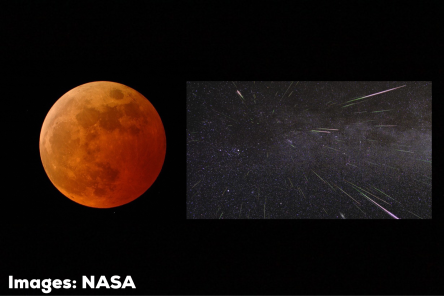
Eclipses and meteor showers always have the potential to be great celestial naked eye spectacles and this November we are being given a shot at both.
NOVEMBER 8: TOTAL LUNAR ECLIPSE
The great thing about this month’s two astronomical happenings is that no expensive equipment is required to observe them. All you need do is sit back, look up, relax, and enjoy. Oh, and you might need some caffeine since both of these events take place during the very early to late morning hours, right before sunrise.
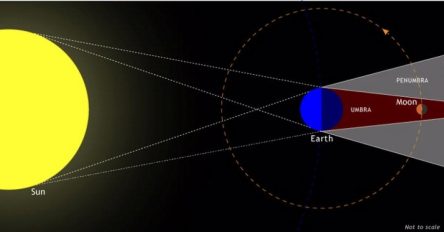 A total lunar eclipse can only happen during a full Moon. At full Moon, the Earth is positioned in between the Moon and the Sun, allowing for the possibility for the Moon to enter the giant cone-shaped shadow that our planet casts out into space. But if we have a full Moon every month, why do we not always see a lunar eclipse? Two reasons. First, the Moon’s orbit, relative to the Earth’s orbit around the Sun, is inclined by 5-degrees. This tilt means that the full Moon-Earth-Sun alignment is not always as precise as needed for an eclipse to occur. Secondly, the Moon’s orbit around the Sun is not a perfect circle, it’s actually in the shape of a somewhat flattened circle known as an ellipse. An elliptical-shaped orbit means that the Moon’s distance from Earth is always varying. On average, the Moon is about 238,900 miles away. Sometimes it can get as close as 225,623 miles and, at its most distant, the Moon can be as far away as 252,088 miles. For a total lunar eclipse to occur, the Moon needs to be in a precise “sweet spot” in order to pass into the deepest part of the Earth’s shadow AND do so at the precise time.
A total lunar eclipse can only happen during a full Moon. At full Moon, the Earth is positioned in between the Moon and the Sun, allowing for the possibility for the Moon to enter the giant cone-shaped shadow that our planet casts out into space. But if we have a full Moon every month, why do we not always see a lunar eclipse? Two reasons. First, the Moon’s orbit, relative to the Earth’s orbit around the Sun, is inclined by 5-degrees. This tilt means that the full Moon-Earth-Sun alignment is not always as precise as needed for an eclipse to occur. Secondly, the Moon’s orbit around the Sun is not a perfect circle, it’s actually in the shape of a somewhat flattened circle known as an ellipse. An elliptical-shaped orbit means that the Moon’s distance from Earth is always varying. On average, the Moon is about 238,900 miles away. Sometimes it can get as close as 225,623 miles and, at its most distant, the Moon can be as far away as 252,088 miles. For a total lunar eclipse to occur, the Moon needs to be in a precise “sweet spot” in order to pass into the deepest part of the Earth’s shadow AND do so at the precise time.
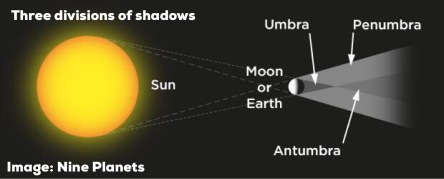 As I said, the Earth casts a cone-shaped shadow out into space. This shadow, seen in cross section, is a circle. Yes, even people in ancient times had deduced that the Earth is a sphere just by observing lunar eclipses. This shadow has three distinct areas. The outer part of the shadow is rather faint and is called the “penumbra” while the dark core of the shadow is the “umbra”. Where the shadow begins to taper down to a point you will find another faint section known as the antumbra. It’s much like the penumbra but forms at a certain distance from the object casting the shadow. It’s not going to be a major player here so let’s just agree to ignore it for now.
As I said, the Earth casts a cone-shaped shadow out into space. This shadow, seen in cross section, is a circle. Yes, even people in ancient times had deduced that the Earth is a sphere just by observing lunar eclipses. This shadow has three distinct areas. The outer part of the shadow is rather faint and is called the “penumbra” while the dark core of the shadow is the “umbra”. Where the shadow begins to taper down to a point you will find another faint section known as the antumbra. It’s much like the penumbra but forms at a certain distance from the object casting the shadow. It’s not going to be a major player here so let’s just agree to ignore it for now.
When the Moon enters the penumbra, not a lot can be seen to be happening, just a subtle dimming of the lunar surface. But, as soon as the Moon glides into the umbra you will notice the difference. For a period of time, the moon will appear to have had a bite taken out of it. In fact, the mythology and superstations of many different cultures explain a lunar eclipse as being the result of demons or giant celestial animals attempting to devour the Moon. Since this particular “blood moon” total lunar eclipse falls on an election day, November 8th, feel free to read into that what you will (but, whatever you do, please vote!).
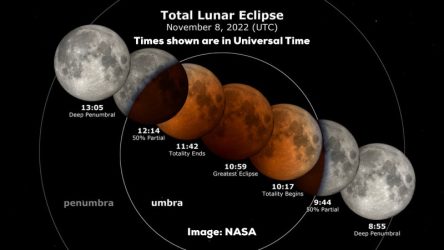 As the Moon becomes enveloped by the umbra you will begin to see the once silvery surface turn a rusty red color. Remember, during a full Moon, the Earth is being backlit by the Sun. The Sun’s light is now being filtered by our precious life-sustaining atmosphere. In doing so, the short wavelength, bluer portions of the Sun’s light get scattered by particles in the atmosphere, while the longer wavelength, redder portions, pass right on through. It’s the same phenomenon that makes our skies appear blue and sunsets red. Physicists call it “Rayleigh scattering” (named for the 19th century British physicist, Lord Rayleigh). It’s those longer wavelengths of red being projected onto the lunar surface that are responsible for our so-called “blood Moon”.
As the Moon becomes enveloped by the umbra you will begin to see the once silvery surface turn a rusty red color. Remember, during a full Moon, the Earth is being backlit by the Sun. The Sun’s light is now being filtered by our precious life-sustaining atmosphere. In doing so, the short wavelength, bluer portions of the Sun’s light get scattered by particles in the atmosphere, while the longer wavelength, redder portions, pass right on through. It’s the same phenomenon that makes our skies appear blue and sunsets red. Physicists call it “Rayleigh scattering” (named for the 19th century British physicist, Lord Rayleigh). It’s those longer wavelengths of red being projected onto the lunar surface that are responsible for our so-called “blood Moon”.
November is often a cloudy month here in Arkansas so let’s hope for clear skies during the morning hours of the 8th because North America will not see another total lunar eclipse until March of 2025. The chart below is from Time and Date, and it shows the times for the different sequence of events for this month’s eclipse.
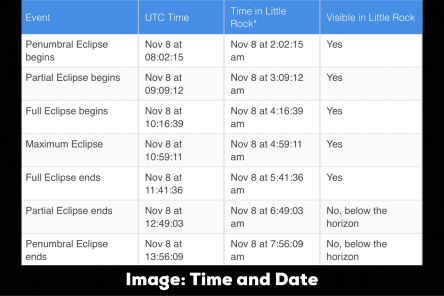 Should we get clouded out, do not despair, NASA has this recommendation:
Should we get clouded out, do not despair, NASA has this recommendation:
“Numerous organizations and individuals around the globe present live streams and videos of lunar eclipses. An online search will provide multiple options for viewing from your computer screen. You can also visit NASA’s Dial-a-Moon for a visualization of the eclipse.”
LEONID METEOR SHOWER
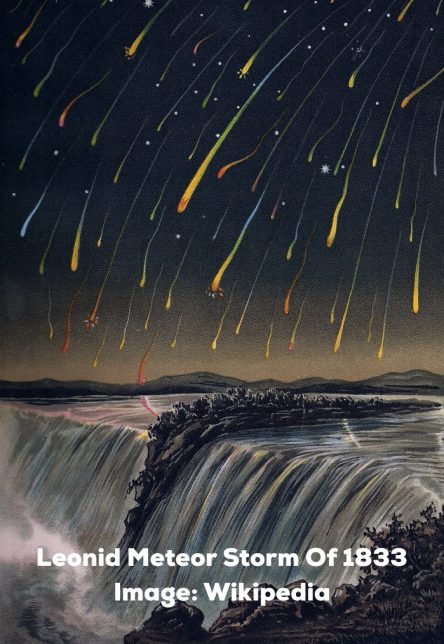 Our next celestial highlight this month is a meteor shower and one that has some notoriety to it. The Leonid meteor shower typically produces a modest 15 meteors per hour but, every 33 years or so, this trickle of meteors can become a torrent. At this point, we are no longer talking about a shower but a storm. In the year 1833, observers across parts of the US, saw hundreds of thousands of meteors per hour. On the morning of November 17th, 1966, folks living in the American southwest, for one 15-minute period, were stunned by the sight of 40 to 50 meteors per second. That translates into 2,000 the 3,000 meteors per minute. Witnesses to such events have been said to have dropped to the ground, clinging on for dear life because of the illusion created that the Earth was suddenly zooming off into space.
Our next celestial highlight this month is a meteor shower and one that has some notoriety to it. The Leonid meteor shower typically produces a modest 15 meteors per hour but, every 33 years or so, this trickle of meteors can become a torrent. At this point, we are no longer talking about a shower but a storm. In the year 1833, observers across parts of the US, saw hundreds of thousands of meteors per hour. On the morning of November 17th, 1966, folks living in the American southwest, for one 15-minute period, were stunned by the sight of 40 to 50 meteors per second. That translates into 2,000 the 3,000 meteors per minute. Witnesses to such events have been said to have dropped to the ground, clinging on for dear life because of the illusion created that the Earth was suddenly zooming off into space.
Will this year produce such a spectacle? Unfortunately, no, it’s not very likely. However, there are some meteoriticists (sadly, the term “meteorologist” had already been claimed by the weather folks) who are expecting an outburst of some sort for this year’s Leonids. But before we delve into that, let’s get some basics out of the way.
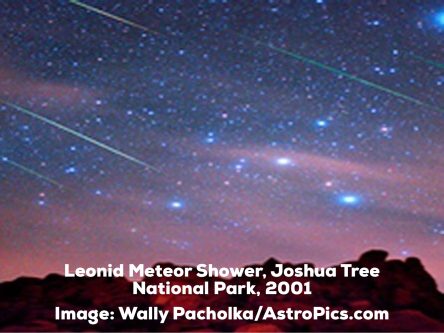 Meteors are often referred to as “shooting stars” but of course they are no such thing. On any given night, you stand a good chance of seeing a few meteors provided that you are observing from a dark sky location. Each meteor streak you see in the sky is the result of a bit of ice, rock, or metal, burning up in the Earth’s atmosphere and they are typically no bigger than a grain of sand.
Meteors are often referred to as “shooting stars” but of course they are no such thing. On any given night, you stand a good chance of seeing a few meteors provided that you are observing from a dark sky location. Each meteor streak you see in the sky is the result of a bit of ice, rock, or metal, burning up in the Earth’s atmosphere and they are typically no bigger than a grain of sand.
Meteor showers result when the Earth passes through a stream of the particle-sized debris left behind from the wake of a comet. Comets are often mountain-sized objects made from loosely packed ice and rock. They normally exist on the outer edges of our solar system but, on occasion, their orbits become perturbed, and they find themselves careening in towards the Sun. As they get closer to the Sun, say out near the orbit of Mars, their ices warm up and the comet begins to eject gas and dust, leaving a long stream of debris in their wake. It’s this material that will burn up in the atmosphere, creating the spectacle of a meteor shower. Well, I say “spectacle’ but your mileage may vary depending upon the meteor shower in question and its productivity.
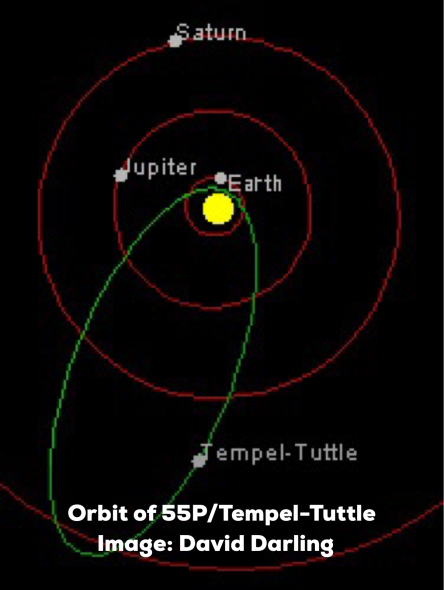 The parent comet for the Leonid meteor shower is 55P/Tempel-Tuttle, discovered first in 1865 by astronomer Ernst Tempel and then again, independently, in 1866 by Horace Tuttle. It’s a rather small comet, with a nucleus (the main body of the comet) that measures some 2.24 miles across. It only takes 55P/Tempel-Tuttle 33 or 34 years to make one complete lap around the Sun and, each time it does so, it lays down a stream of debris. Over time, these streams of meteor dust widen out but some of 55P’s streams contains denser regions than others and it’s these denser sections that, on occasion, produce meteor storms. Or at least, an occasional outburst.
The parent comet for the Leonid meteor shower is 55P/Tempel-Tuttle, discovered first in 1865 by astronomer Ernst Tempel and then again, independently, in 1866 by Horace Tuttle. It’s a rather small comet, with a nucleus (the main body of the comet) that measures some 2.24 miles across. It only takes 55P/Tempel-Tuttle 33 or 34 years to make one complete lap around the Sun and, each time it does so, it lays down a stream of debris. Over time, these streams of meteor dust widen out but some of 55P’s streams contains denser regions than others and it’s these denser sections that, on occasion, produce meteor storms. Or at least, an occasional outburst.
The peak of the Leonids is on November 17th, just after midnight when the radiant, the section upon the sky from which most of the meteors appear to originate, rises. The radiant just indicates the direction out in space where the meteor stream is located and for the Leonids, that happens to be within the constellation of Leo, hence the name for the shower. But that’s not the night for which this year’s outburst will take place, that is predicted to occur on the night of the 19th at around 1:00 AM. Two different meteoriticists, folks whose area of expertise is the dynamics of meteor streams, predict that the Earth will pass through a dense portion of a stream laid down back in 1733 by 55P/Tempel-Tuttle. Russian meteoriticst, Mikhail Maslov says the outburst could produce up to 250 meteors per hour. Japanese meteoriticist Mikiya Sato says around 50. That’s a fairly big discrepancy and it highlights the fact that predictions of meteor shower numbers are far from being an exact science. On the other hand, as we continue to learn more about these streams and construct better models, we have gotten better at forecasting such things. Does that mean we are likely to see a great show? I have no idea but, skies permitting, I will be outside and looking up with hopeful eyes.
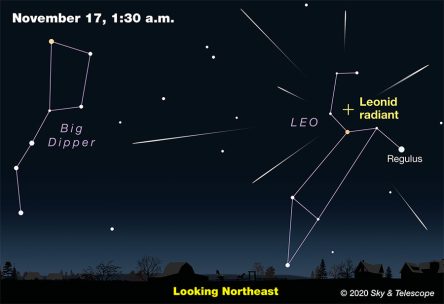 The best times to look for Leonids on the peak night will be after midnight and the radiant will not reach its highest point until just before dawn. So, anywhere after midnight will be the best times to look but your chances of seeing the most won’t be until the wee hours before sunrise. Don’t focus exclusively on the radiant, which rises in the east after midnight, as meteors can appear in just about any area on the sky. Dress warmly, get comfortable in a reclined position, have warm beverages on hand, bring snacks, and enjoy. I also cannot stress the absolute need to be observing as far away from city lights as possible. Also, the Moon phase is at last quarter so it should be setting before the best viewing hours and won’t be too much of a nuisance.
The best times to look for Leonids on the peak night will be after midnight and the radiant will not reach its highest point until just before dawn. So, anywhere after midnight will be the best times to look but your chances of seeing the most won’t be until the wee hours before sunrise. Don’t focus exclusively on the radiant, which rises in the east after midnight, as meteors can appear in just about any area on the sky. Dress warmly, get comfortable in a reclined position, have warm beverages on hand, bring snacks, and enjoy. I also cannot stress the absolute need to be observing as far away from city lights as possible. Also, the Moon phase is at last quarter so it should be setting before the best viewing hours and won’t be too much of a nuisance.
Even if there is no meteor shower outburst, keep in mind that the Leonids also have a few other cards up their sleeve. According to NASA…
“Leonids are also known for their fireballs and Earth-grazer meteors. Fireballs are larger explosions of light and color that can persist longer than an average meteor streak. This is due to the fact that fireballs originate from larger particles of cometary material. Fireballs are also brighter, with magnitudes brighter than -3. Earth-grazers are meteors that streak close to the horizon and are known for their long and colorful tails.”
Meteors and blood Moons! This month has some wonderful viewing opportunities for us stargazers so, get outside and keep looking up in both awe and wonder.